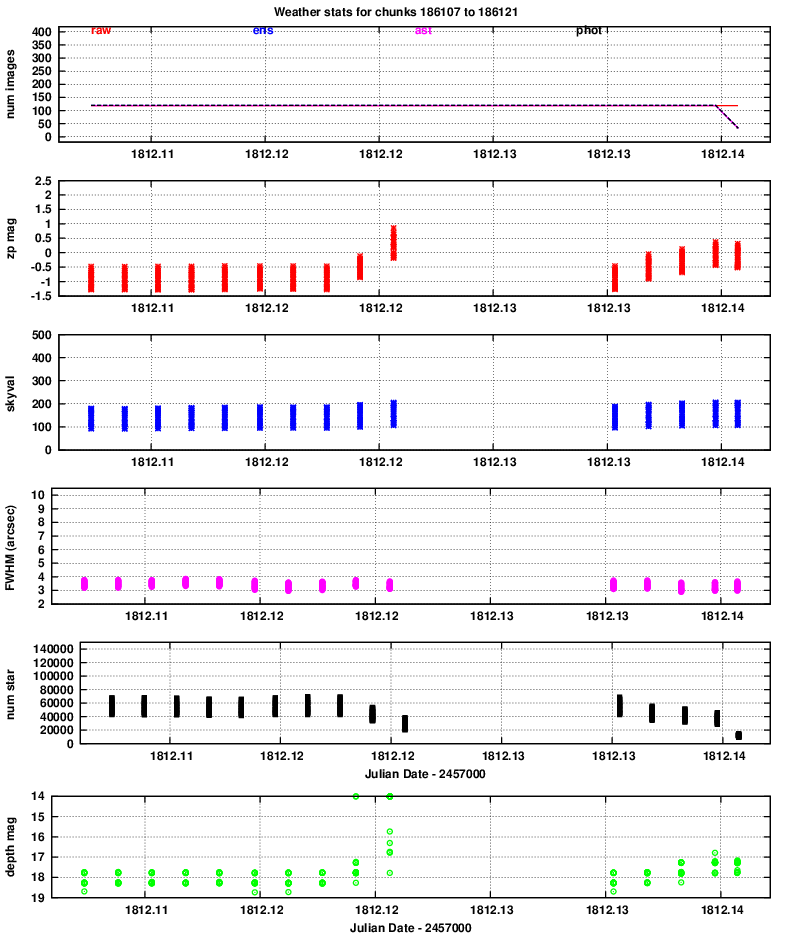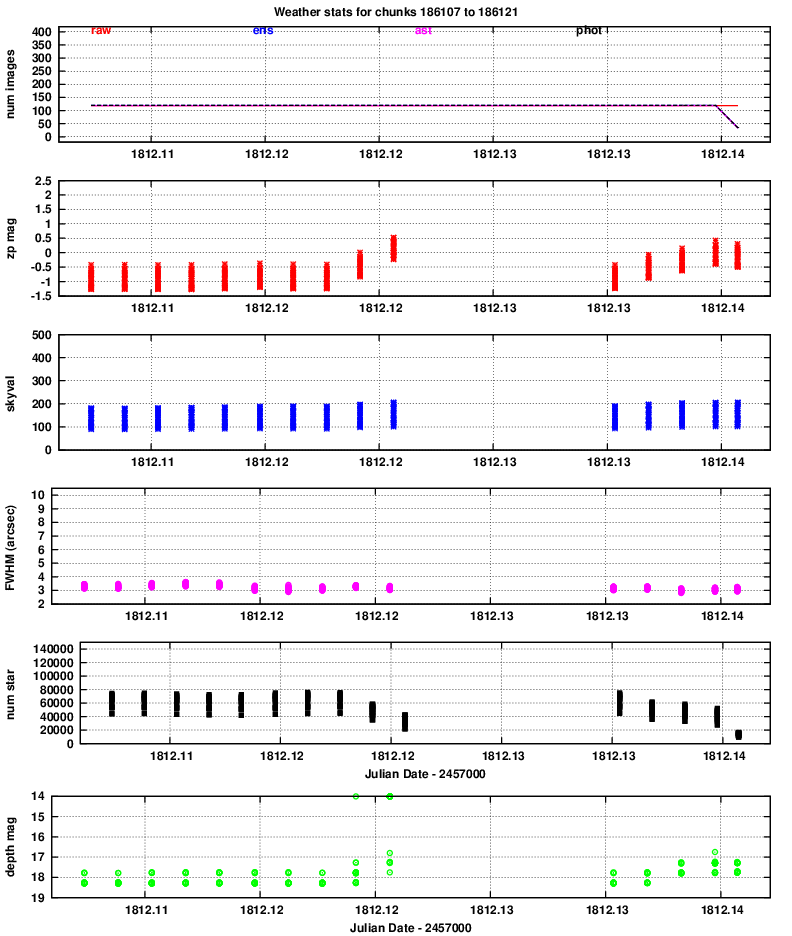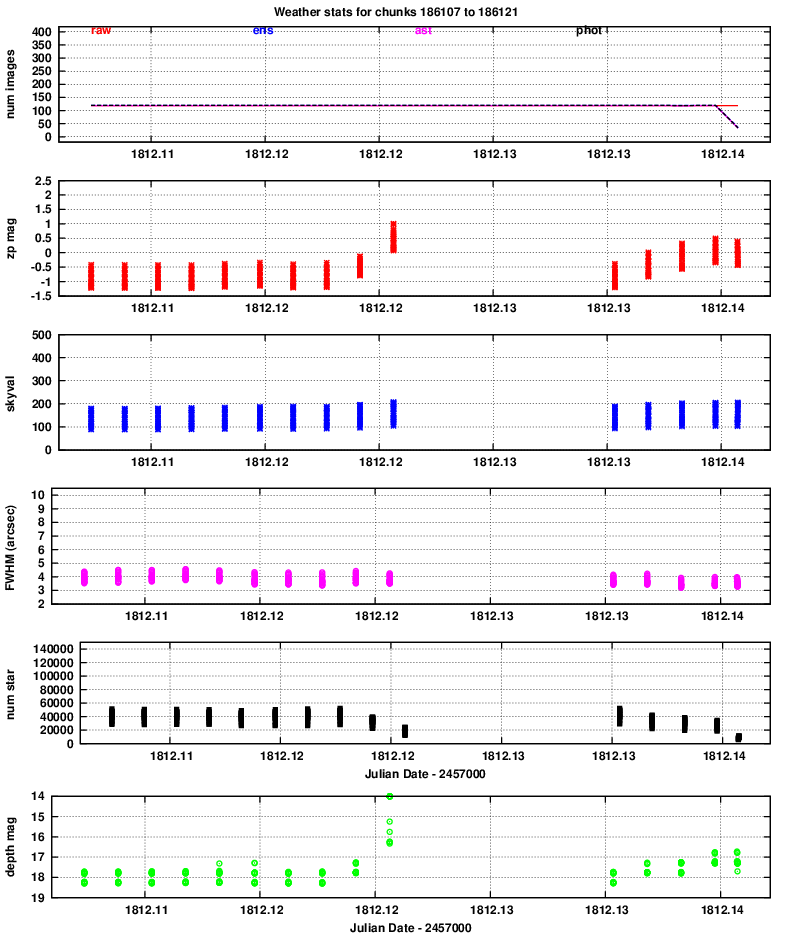
I have analyzed a dataset involving all 84 chips. The run is interrupted in the middle (by clouds?), and so contains only 32 minutes worth of data. No promising candidates were found, but three of the candidates were faint (known) asteroids, and one is a faint star with high proper motion.
The dataset "20191124" is based on images acquired during UT 2019 Nov 24. The images cover the span of time
2458812.1066740 ≤ JD ≤ 2458812.1365636
which is about 32 minutes.
The FITS headers of one of these images states, in part:
OBJECT = 'J0354+1749_dith1' / object name EXPTIME = 119.988480 / [s] total exposure time TELAPSE = 120.500020 / [s] elapsed time EXPTIME1= 0.999904 / [s] exposure time per frame TFRAME = 1.000000 / [s] frame interval in seconds DATA-FPS= 1.000000 / [Hz] frame per second DATA-TYP= 'OBJECT' / data type (OBJECT,FLAT,DARK) OBS-MOD = 'Imaging' / observation mode FILTER = 'BLANK' / filter name PROJECT = 'Earth Shadow Survey (1Hz)' / project name OBSERVER= 'Noriaki Arima' / observer name PIPELINE= 'wcs,stack,raw' / reduction pipeline templete
The images were reduced and cleaned by others; I started with clean versions of the images. Each set of 120 images was packed into a single FITS file, covering a span of (120 * 1.0 sec) = 120 seconds. These "chunk" files were located on shinohara in the directory
/gwkiso/tomoesn/raw/20191124
with names like
rTMQ2201911240018612114.fits
These names can be decoded as follows:
r stands for "reduced" ??
TMQ2 means "Tomoe data, part of quadrant 2"
20191124 means year 2019, month 11, day 24
00186121 means chunk index 00186121 (increases with time)
14 means chip 14
.fits means a FITS file
I'll refer to each of these "composite" files as a "chunk".
There are typically 15 chunks for each chip, and a total of 1245 chunks in the entire dataset. Each chunk file was 1083 MByte, so the total volume of the chunk files was about 1348 GByte = 1.3 TByte.
I ran a slightly modified version of the Tomoe pipeline on the images; it was not the same as that used to analyze the 2016 images discussed in the transient paper for two reasons:
The main stages in the pipeline were:
The output of the pipeline includes a copy of each FITS image, plus a set of ASCII text files which include both the raw, uncalibrated star lists, and the calibrated versions of those lists, as well as the ensemble output.
After running the pipeline to reduce the data, clean the images, find and measure stars, calibrate them astrometrically and photometrically, I used a script to look at properties of the data over the course of the night. You can read more about the "weather" in another note.
Below are links to the graphs produced for each of the 4 quadrants.
Quadrant 1:

Quadrant 2:

Quadrant 3:

Quadrant 4:

zp = (instrumental_mag) - (calibrated_mag)
Large positive values indicate extinction due to the atmosphere or clouds.
It appears that clouds moved over the telescope and interrupted observations.
It is clear that the FWHM for quadrants 3 and especially 4 is (as usual) considerably larger than that of quadrants 1 and 2.
The images show a "depth" of about 18 at best, and that depth becomes much shallower just before the interruption. That makes sense if the interruption was due to clouds.
After all the data had been calibrated, I ran the "transient_a.pl" script, which applies the rules described in the Tomo-e transient search paper to look for sources with only a brief existence. The code also computes a "control time" for the dataset.
The software found 45, 80, 37, and 32 candidates in quadrants 1, 2, 3, and 4, respectively. I created a web page showing the properties of these candidates in each quadrant:
The entry for each candidate includes some information about the chunk in which it appears, its position in (x,y) pixel coordinates and (RA, Dec) coordinates, and its magnitude. The "variability score" describes the ratio of the standard deviation of its magnitudes away from the mean to the standard deviation from the mean of stars of similar brightness; so, a high score means the object is varying from frame to frame more than most objects of similar brightness.
The entries for quadrants 2, 3, and 4, contain columns listing the magnitudes of any objects at this position (to within 5 arcsec) in the USNO B1.0 (avergage of R-band magnitudes) and in the 2MASS catalog (K-band magnitude). A value of "99.0" indicates that no source appears in the catalog as this position. You can see that the overwhelming majority of candidates do correspond to objects which were detected in one or both of these catalogs -- meaning that they are not true transients.
After these columns of text, the documents contain thumbnails of the images around the candidate. The thumbnails are oriented with North up, East left, and are 110 pixels (= 130 arcsec) on a side.
Interesting candidates are:
The table below shows the control times for each quadrant in this dataset:
quadrant control time (square degrees * sec)
V=13 V=14 V=15 V=16 V=17
-------------------------------------------------------------
1 8457 8457 8457 7565 1380
2 8457 8457 8457 7766 2301
3 8054 8054 7996 6370 201
4 8021 7995 7743 5803 0
total 32989 32963 32653 27504 3882
-------------------------------------------------------------
These control times are comparable to those for each of the nights listed in the transient paper;